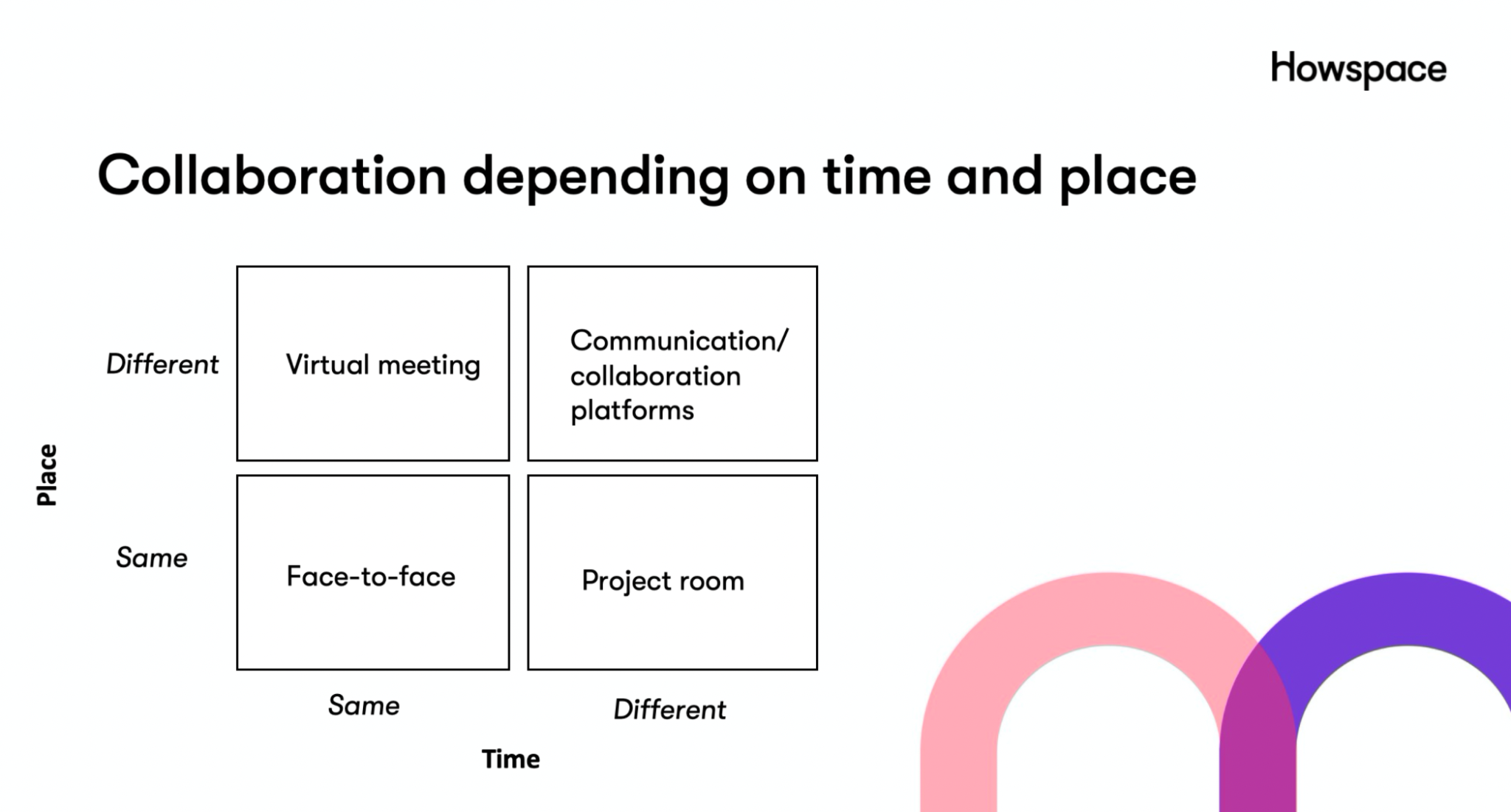
What’s the difference between digital and face-to-face facilitation?
With the rise of virtual and hybrid work, people are thinking more about how to choose when to collaborate in person, virtually, or a mix of both. How do you pick the right facilitation method when working on people-centric processes like organizational development or learning?
When we talk about the contexts of organizational collaboration, it’s important to consider both time and place.

Simply put, sometimes we collaborate at the same time (synchronous), when we have face-to-face or virtual meetings. Other times, we collaborate at different times (asynchronous).
Every task, no matter how big or small, is going to require a different facilitation approach. In this post, we’ll break down the difference between virtual and face-to-face facilitation, define asynchronous facilitation, and explain how these are all different formats of digital facilitation. With this breakdown, you’ll be better equipped to choose the right approach for your next workshop, project, or process.
Grab our free template for hybrid workshops and get some inspiration for your next workshop!
Face-to-face facilitation
Let’s start with the most familiar: Face-to-face facilitation means facilitating a group of people in the same physical place at the same time. Pretty much all traditional meetings and workshops rely on face-to-face meetings, but you can also use digital tools to facilitate the process, rather than relying on physical flip charts and sticky notes.

The benefits of face-to-face facilitation include:
- Relationship building
- Shared context
- Access to nonverbal cues like expressions and body language
The downsides of face-to-face facilitation include:
- Limited length of interaction
- Deeper knowledge sharing siloed to small groups
- Travel time and costs
- Disruptive in nature
- Manual post-workshop documentation
- Limited number of attendees
Face-to-face meetings and workshops are suitable for situations with a specific agenda and a clear, short-term goal. However, when it comes to longer and more complex processes, face-to-face interactions should be complemented with ongoing, asynchronous communication to ensure that the team continues to work beyond workshops.
Virtual facilitation
Virtual facilitation is when a facilitator guides a group of people remotely in real time. Video conferencing tools like Zoom, Microsoft Teams, or Google Meet are typically used during virtual facilitation. In short, virtual facilitation takes place at the same time (synchronous) but participants join from different places.

The benefits of virtual facilitation include:
- Increased productivity – no time spent on travel
- Cost savings – no money spent on travel
- No need to worry about meeting logistics (like booking a big meeting room or organizing refreshments
The disadvantages of virtual facilitation include:
- Limited length of interaction
- Limited access to facial expressions and other nonverbal cues
- Lack of context (A great read: why context is important in the workplace)
- Limited relationship-building opportunities
- Limited opportunities for one-to-one communication
- Limited number of attendees
- Poses technical requirements: high speed internet and a virtual meeting tool
Much like face-to-face facilitation, virtual facilitation is suitable for meetings and workshops with a limited number of attendees and a clear goal. Successful virtual facilitation requires a skilled facilitator.
Hybrid workshops and meetings—where some participants attend remotely while others are in the same physical location—can be particularly challenging for facilitators. If you’re running hybrid meetings, check out our blog post covering 10 facilitation techniques that will make your hybrid meetings more engaging.
Asynchronous facilitation
Asynchronous facilitation is when a facilitator leads participants remotely at different times. The most common way we communicate today is with asynchronous tools like email and Slack, which enable us to interact remotely when it suits us.
The shortcoming of communication tools like Slack, is that they lack features for facilitating conversations and making decisions. Conversations tend to get lost in endless threads, and it can be impossible to organize all the materials and discussions from a workshop through these types of tools. This is where leveraging a digital facilitation platform can really make a difference.
In short, asynchronous facilitation happens at a different time and at a different place.
Digital facilitation
Digital facilitation is an umbrella term that covers face-to-face facilitation using a digital platform (like, hey, Howspace), virtual facilitation, and asynchronous facilitation such as the exchange of emails and instant messages. In other words, digital facilitation combines asynchronous and synchronous collaboration with remote and physical interaction, and by doing so, allows the facilitator endless possibilities to engage with the participants.
In short, digital facilitation means helping a group of people reach their common goals with the help of digital tools. Digital tools are valuable in all of the boxes in the graphic shown above. When we are separated by location and time, digital tools are necessary. But even in a face-to-face meeting, you may have a digital tool for documenting and for connecting the participants with each other.

The benefits of digital facilitation include:
- Increased flexibility
- Unlimited number of participants
- Enables asynchronous and synchronous multi-way communication
- Extended length of interaction and the ability to collaborate not only during but also before, after, and in between workshops
- Opportunity to combine different facilitation approaches
- Reduced need for post-workshop documentation
- Supports different kinds of personalities, learning styles, and communication styles
The downsides of digital facilitation include:
- The facilitator must be willing and able to learn and adjust
- Poses technical requirements: internet connection and a device for each participant
Digital facilitation is suitable for longer engagements like learning programs and organizational change processes.
Ultimately, the discussion of different facilitation methods shouldn’t be about one versus the other. Face-to-face and virtual facilitation both have their benefits. In-person meetings will always play a role in building deeper relationships, and virtual meetings allow for remote work. All facilitation methods are needed for collaborating at work today. That’s why digital facilitation is so important: It allows facilitators to get the most out of every meeting, be it virtual or face-to-face.
Check out our template for hybrid workshops! This template will help you successfully lead the energy levels, as well as the results of a workshop in a hybrid setting when part of the participants are physically present and part participating virtually.
Already a Howspace-user? You can add the template to your account here.

You might be interested in these as well
View all
10 Ways Howspace Uses Howspace
In the SaaS world, we frequently hear the term “eating your own dog food” thrown around, but rarely do we […]

How to facilitate a workshop in 18 simple steps
Want to facilitate a successful workshop? These 18 simple steps will help you get started with successful workshop preparation.

How facilitators can use AI to develop work and learning: 4 research-backed tips
Howspace’s built-in AI helps people listen to each other better and achieve a shared understanding. The benefits of using AI to develop work and learning is now backed up by research.